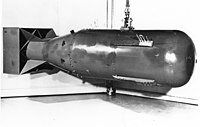
Photo from wikipedia
Since the events of 9/11, a concerted interagency effort has been undertaken to create comprehensive emergency planning and preparedness strategies for the management of a radiological or nuclear event in… Click to show full abstract
Since the events of 9/11, a concerted interagency effort has been undertaken to create comprehensive emergency planning and preparedness strategies for the management of a radiological or nuclear event in the US. These planning guides include protective action guidelines, medical countermeasure recommendations, and systems for diagnosing and triaging radiation injury. Yet, key areas such as perception of risk from radiation exposure by first responders have not been addressed. In this study, we identify the need to model and develop new strategies for medical management of large-scale population exposures to radiation and examine the phenomena of radiation dread and its role in emergency response using an agent-based modeling approach. Using the computational modeling platform NetLogo, we developed a series of models examining factors affecting first responders' willingness to work (WTW) in the context of entering areas where radioactive contamination is present or triaging individuals potentially contaminated with radioactive materials. In these models, the presence of radiation subject matter experts (SMEs) was found to increase WTW. Degree of communication was found to be a dynamic variable with either positive or negative effects on WTW dependent on the initial WTW demographics of the test population. Our findings illustrate that radiation dread is a significant confounder for emergency response to radiological or nuclear events and that increasing the presence of radiation SME in the field and communication among first responders when such radiation SMEs are present will help mitigate the effect of radiation dread and improve first responder WTW during future radiological or nuclear events.
Journal Title: American journal of disaster medicine
Year Published: 2022
Link to full text (if available)
Share on Social Media: Sign Up to like & get
recommendations!